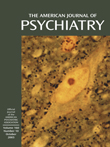Relation of Corpus Callosum and Hippocampal Size to Age in Nondemented Adults With Down’s Syndrome
Abstract
OBJECTIVE: Aging in Down’s syndrome is accompanied by amyloid and neurofibrillary pathology, the regional and laminar distribution of which resembles pathological changes seen in Alzheimer’s disease. Previous studies using magnetic resonance imaging (MRI) demonstrated age-related atrophy of medial temporal lobe structures in nondemented older subjects with Down’s syndrome, reflecting early allocortical pathology. Corpus callosum atrophy has been established as a marker of neocortical neuronal loss in Alzheimer’s disease. This study investigated whether atrophy of the corpus callosum and hippocampus occurs in nondemented subjects with Down’s syndrome and compared the degree of age-related atrophy between these structures. METHOD: Hippocampus and corpus callosum measures were obtained from volumetric T1-weighted MRI scans of 34 nondemented Down’s syndrome adults (mean age=41.6 years, 17 women) and 31 healthy comparison subjects (mean age=41.8 years, 14 women). RESULTS: Down’s syndrome subjects had smaller corpus callosum areas and hippocampal volumes relative to age-matched healthy comparison subjects, even after age and total intracranial volume were controlled. There was an age-related decrease of corpus callosum area (most prominent in posterior regions) and hippocampal volume in the Down’s syndrome group. The degree of the age effect was comparable between the total corpus callosum and hippocampus, and corpus callosum size was correlated with cognitive performance in the Down’s syndrome subjects. There was no correlation between age and corpus callosum or hippocampal size in the comparison group. CONCLUSIONS: Comparable decrease of corpus callosum and hippocampal size with age in nondemented subjects with Down’s syndrome suggests that neocortical neuronal alterations accompany allocortical changes in the predementia phase of Down’s syndrome.



